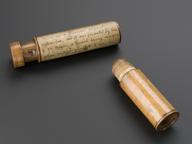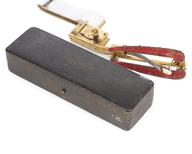

Otoscope, United Kingdom, 1851-1900
- Made:
- 1851-1900 in United Kingdom

Toynbee otoscope, canvas and ivory, probably British, second half 19th century
The otoscope is seen with three Eustachian catheters and an explanatory picture showing it in use. It consists of an ivory-tipped flexible tube. The operator used this to detect whether air blown down the Eustachian catheter (named after the part of the body it is used to examine) reached the patient’s middle ear. The otoscope was invented by Joseph Toynbee (1815-66). He was an aural surgeon and lecturer at St Mary’s Hospital in Paddington.
Toynbee wrote two key 19th century books concerning ear diseases and their treatments. Unfortunately, he died at home after accidentally inhaling prussic acid and chloroform during research.
Details
- Category:
- Clinical Diagnosis
- Collection:
- Sir Henry Wellcome's Museum Collection
- Object Number:
- A647369
- Measurements:
-
overall: 720 mm x 7 mm, .07kg
- type:
- otoscope




